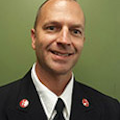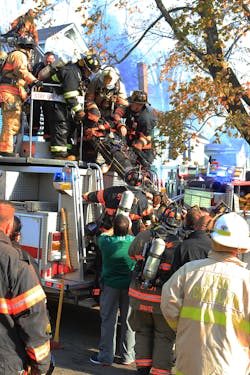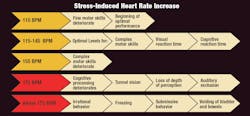“Mayday, mayday, mayday!” Hearing this word over the radio, repeated three times by a familiar voice with a spine-tingling tone, is not a routine situation for firefighters, nor one with which they are comfortable. You train, you prepare, you talk about it. But really, how prepared are you for a mayday?
When one of our firefighters goes down in a structure, the reality of our preparation for maydays is exposed. There is no discrimination for big city, small town, full-time or volunteer firefighters. Mayday is universal and affects us all equally.
A cardiac event, floor collapse, separation from the crew, lost or disoriented member are all possible scenarios for a mayday. We have ownership in the firefighter who called the mayday. We know this person and spend time with them and their family. We have a responsibility to them and their loved ones. That responsibility should not start immediately after the mayday is called. We must know how to manage these situations long before the actual event. We do this by ensuring that we are paying attention to the details of what it really takes to save one of our own—and practicing in realistic conditions.
Preparation
If your rapid-intervention team (RIT) training looks a lot like your search and rescue (for civilians) training, then you have a problem. Think about the drills you have completed. On Tuesday, your crew conducts search and rescue training in which a firefighter plays the part of the victim and finds a spot in the firehouse to “hide out.” You go in with your crew in full gear, air pack on, and mask blacked out. You choose a right wall search and eventually find your victim. A 360 is completed around the victim, they get packaged up and dragged out the front door. You tell each other how great everyone did and sign the training roster. Check the box, training complete.
Now it’s Friday and time for a RIT drill. A firefighter plays the victim, this time in full gear. They find a place in the firehouse to “hide out” and the drill begins. You go in with your crew and choose a right wall search where you eventually come across the victim firefighter. A 360 is completed around the victim, a transfill is completed, the victim is packaged up and dragged out the front door. Once again, you tell each other how great you did and sign the training roster. Now you are ready for the big one, or so you think.
We've all done these exact scenarios. Unfortunately, using such a linear approach to RIT training is only reinforcing in your brain that rapid intervention is based on simple-to-moderate skills execution, minimal need for solid leadership and decision-making, and easy physical obstacles to overcome in a non-stressful environment. We are setting ourselves up for failure and ultimately failing to take responsibility for each other. This failure is going to manifest when the situation is real and it’s one of your firefighters calling the mayday inside a burning building. A high level of stress will be involved, emotions will kick in and cloud decision-making, and tunnel vision is highly likely to set in.
Many training officers and company officers are doing great things to develop creative mayday/RIT scenarios that offer realistic training evolutions. But the reality is that many fire departments across this country are failing to provide realistic mayday training that incorporates the elevated stress and physical conditions of a rapid intervention scenario.
There are many reasons—or more likely, excuses—for this. Logistically, it’s difficult to get acquired structures, and it takes money to build props. And perhaps there’s also a level of complacency that a mayday is a low-frequency event, so members opt to train on other things instead. These challenges are certainly real, but they should not be used as excuses for not having a vision, setting goals, and working hard to remove barriers that would keep you from providing realistic mayday training. After all, these are our crewmembers we’re talking about. Don’t we want to prepare under the most true-to-life conditions as possible so we might increase the likelihood of saving our own?
Unlike the civilian trapped inside of a burning building, a firefighter has additional protection. Thermal and respiratory protections are the major contributors that allow us to enter these environments and survive as we perform our tasks. When there is a line-of-duty death (LODD) with a firefighter inside a structure fire, they are succumbing to a respiratory insult (asphyxiation, airway burns, smoke inhalation, etc.) more than any other issue. When a mayday call goes out over the radio, the firefighter is limited to the remaining air on their back. Time is a factor. We can’t afford to waste a single second in the rescue effort.
From the firefighter victim perspective, there are three phases to their rescue: 1) Get here now, 2) keep me alive and 3) get me out. Of these three phases, the area where we often fail in our responsibility to that firefighter is the first—get here now. The RIT needs to get there prior to the victim’s bottle going dry. When our training is focused on the details of efficiency and preparation in realistic, elevated-stress scenarios, then we increase the possibility of getting there before the bottle goes dry. This is the mindset and the proper approach to mayday/RIT training. Keep in mind, air is the primary focus in most mayday situations and should be the top priority of the initial RIT. Once they reach the firefighter victim (get here now), then they can provide that additional air to buy some time (keep me alive) until an extrication plan is worked out (get me out). The officer, or lead, of the initial RIT evaluates the needs for extrication and communicates that to the incident commander (IC) or rescue group supervisor.
Communications
On the incident scene, we communicate regularly in support of the strategy, tactics and tasks being performed. We know how important communication is to our job—how it is such a high priority in our effectiveness and how a failure in communication could result in injury or death—but how much do you actually “practice” your communication? If you are like most other fire departments, then the answer is that you don’t practice communicating much, if at all.
Imagine yourself in a mayday situation where you are low on air, you can’t get out and are relying on the effective and efficient, high-performing, skilled members of your department to save you and return you to your family. If you somehow knew that you had eight remaining breaths left in your bottle (your life), would you want your rescuers to be great communicators amongst themselves as a crew and on the radio as needed? The answer is, of course, yes! They better not waste any time miscommunicating. We know that one missed message and a request to repeat that message could eat up very valuable time.
Without communication training in an elevated-stress environment, the physiological response to stress hormone-induced heart rate increases will not be favorable during the real event. Just like many of you, I have witnessed situations where the elevation of stress caused the amount of talking among crewmembers to go up and the amount of listening to go down. This is nothing short of working against yourself and adding barriers to the possibility of a successful rescue. Firefighters experience combat stress during a firefight and, along with that, the effects of stress hormones cause your heart rate to increase. This stress-induced heart rate increase is not compliant in your quest to be a highly skilled firefighter in a time of urgency. Without practice in this arena, the following physiological effects will become a significant problem at some point.
A reduction in your cognitive reaction time and processing, along with increased tunnel vision and auditory exclusion, will compromise your ability to be an effective communicator.
As you develop training that includes realistic and elevated stress levels, evaluate communications as a part of the training objectives. Improvements can often be made in controlling the breathing. Prior to keying the mic, take a breath. This will buy you time as you put your thoughts together and help to manage your heart rate.
Maintaining a calm voice inflection over the radio will saturate the fireground with a message within your message. They are hearing a person who has a sense of calm and control, is able to think and process, and has discipline during uncertainty—all this simply from paying attention to your voice. A mayday isn’t the time to try this out for the first time. You have more important things at that moment to consume your focus. Practice this effective radio communication every drill and on every routine (and not so routine) call. This will eventually change habits and become the normal mode of operation regardless of the stress level involved.
Crew integrity
The integrity of our crew inside the immediately dangerous to life and health (IDLH) environment is of utmost importance. We practice voice, visual or touch from the beginning of recruit school. This is everyone’s responsibility. But the officer in charge of the crew has the ultimate responsibility for the integrity and safety of those members. The officer should pay attention to the bigger picture and ask key questions: What are the conditions and are they changing? Are we making progress or are we facing continuous obstacles? How are the members of my crew? Are they operating efficiently or succumbing to stress?
Air management is a significant safety aspect of crews working in an IDLH, but even more so when attempting the rescue of a brother or sister firefighter. The officer must be paying attention to the air management plan and ensuring that the team is not working into their reserve air. Doing so only increases the risk of a multiple mayday situation when that line is crossed. The more victims there are to rescue, the less likelihood of success for all victims involved.
Develop an air management plan prior to entering the structure, communicate that plan with all members of the crew, and then follow the plan to ensure the safety of your crew. In one of my realistic, hands-on, rapid intervention drills, I had an evolution where the crew was slowly entering a situation where their integrity needed to tighten up as they moved on. Although they were within voice, visual or touch contact as a team, the officer was not able to receive information in a timely manner from some of the crewmembers. This delayed critical decision-making capabilities of the officer in a dynamic, stressful environment.
Over 100 crews were put through this training, and the location of the officer in the crew made a significant difference in crew integrity and safety, as well as their ability to receive critical information that facilitated appropriate decision-making under stress.
- Officer in middle: Crews that had the officer somewhere in the middle position between the lead and the other members had the most success. They were able to receive information from the front and back, communicate efficiently both ways, pay attention to all the members, and still have the broad view of the conditions around them.
- Officer in the front: The lead position is the most narrow-focused, task-oriented person on the crew, and it was detrimental to the integrity and safety of the crew when the officer was the lead.
- Officer in the back: This became a problem when vital information from the lead person was not getting back to the officer in a timely fashion. For example, the lead was heading into an area of diminishing clearance and significant obstacles. The officer didn’t know this until that lead person had already committed. The officer would have likely made another decision had they known that information a little sooner.
Having the officer located in a position that promotes immediate contact and control with all the crewmembers is vital.
Actions on scene
When a crew is assigned as the RIT on the fire scene, this should be taken very seriously. Although it is not very likely that a mayday will occur, the mere possibility of a mayday makes this assignment a huge priority. Don’t be lazy, and never take shortcuts.
The best way to rescue firefighters is to ensure they never have to call a mayday in the first place. Soften the structure, light up the ingress/egress points, get the ground ladders off your apparatus and place them at the upper floor windows, set up a tool cache, and gather intel. The RIT officer needs to acquire vital information about the location and extent of the fire, the layout and condition of the structure, the ingress/egress points, location of the crews working inside, visible or possible hazards, and any other pertinent information that would be useful if they were deployed to attempt a rescue. Completing a 360 of the structure will provide a larger portion of this needed information.
When the officer returns to the crew after their 360, all that intel must be shared with the other members of the RIT. The more knowledgeable all RIT members are of the big picture situation, the more chances for success.
With all this being said about the need for RIT preparedness, don’t forget about the “inside-out” approach to rescuing firefighters in a mayday situation. Other crews operating in the hazard zone are far more likely to reach the mayday firefighter before a RIT can get inside. If other crews are in the vicinity and able to safely abandon their current detail, the IC should call on those crews first. Do not self-assign! The IC must know where all crews are operating and have control over what they are currently doing. This is vital for the safety and accountability of all members in the hazard zone. The IC may or may not deploy the RIT as well. This is all dependent upon the situation at hand.
In sum
Mayday and rapid-intervention training is much more than just training with a stress component, but this is certainly an area where we need some improvement as a fire service. Firefighters must also be proficient with the details of every skill they are expected to know and perform. And company officers must be proficient at leading a team in combat and coordinating their crew’s assignment with accuracy and confidence. The entire crew must produce a unified and choreographed effort like a well-oiled machine. Don’t be “that department.” Be prepared for the unthinkable. Hold yourself accountable and hold others accountable for training and preparation. You will rely on these people just as they will rely on you when the floor fails and one of you goes down. Don’t hide in the cracks when it’s time to do the drill that makes you uncomfortable. Instead, be the first to raise your hand and step up to the challenge. Take the weaknesses (that we all have) and meet them head-on until they are no longer weaknesses. Apply your strengths to the training and teach someone who has room for improvement. And, most importantly, get creative and develop firefighter rescue training that has an element of realistic stress. A runner doesn’t train for a marathon by doing the 100-yard dash every day. Train like you fight, and fight like you train. When it comes to protecting and saving each other, being average is not good enough.
BIO
Paul Strong has been an educator in the public and private sectors for over 24 years, currently serving as a battalion chief at the Valley Regional Fire Authority in King County, WA. He is an adjunct instructor for the Washington State Fire Training Academy as well as the Washington State Criminal Justice Training Commission. For more information, visit 3sixtytraining.com.
About the Author

Paul Strong
Paul Strong entered the fire service in 1990. He is currently a shift captain and acting battalion chief at the Valley Regional Fire Authority in King County Washington and owner of 3 Sixty Training. Strong has served as a training officer, incident safety officer, medical program specialist, hazmat technician and a member of the Technical Rescue team. As an educator, Strong speaks at conferences, training officer’s associations, and individual fire departments. He is the creator and lead instructor of RIC for REAL, Going the Distance on Your Road to Leadership, and Fire Ground Practices - First on Scene. He is an adjunct instructor at the Washington State Fire Training Academy and an affiliate member of the Pacific Northwest chapter of Firenuggets. For more information, visit www.3sixtytraining.com.

